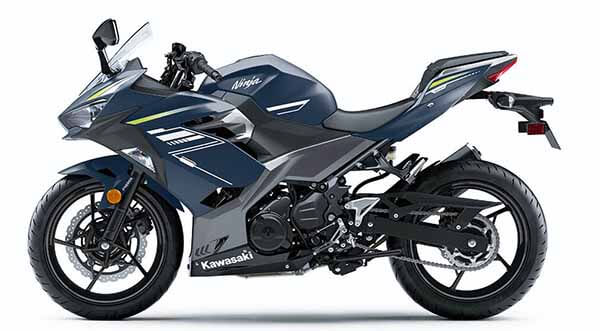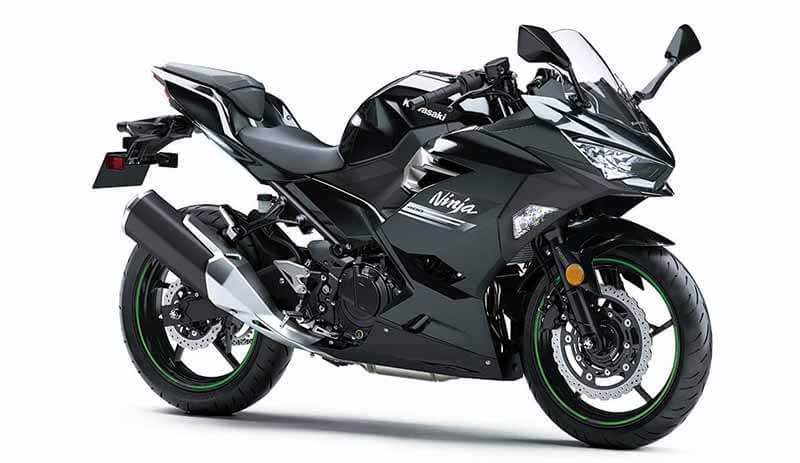Entry-level Kawasaki Ninja models have for quite some time been well known among fledgling riders and amateurs since they offer games bicycle thrills in a protected and charming bundle.
The Ninja 250 was the first, trailed by the Ninja 300, and presently the Ninja 400 has dominated. The Kawasaki Ninja 400, which was appeared in 2017, is the most practical motorbike in Kawasaki’s eminent games bicycle family.
Is the Kawasaki Ninja 400 a beginner bike?
Ninja 400 is a fantastic beginner bike with plenty of power and speed to get you into trouble. To put things in perspective, people have been killed while riding bicycles. It might be the only motorcycle you’ll ever need, but it’ll be fun to ride and won’t leave you wanting more.
What are the competitors of Kawasaki Ninja 400?
The Yamaha R3, a superb twin-chamber passage level games bicycle from Japan, is an immediate test to the Ninja 400. Anybody searching for a little games bicycle might pick the single-chamber KTM RC 390, which conveys similar degrees of execution and fervor.
Kawi is making strides, however, Yamaha is standing firm with the 321cc YZF-R3 as its entrance-level game bicycle.
As far as to plan, the Ninja 400 has customary supersport aspects and is similarly pretty much as dazzling as its senior siblings. The three tones accessible are Metallic Matte Twilight Blue/Metallic Graphite Gray, Metallic Carbon Gray/Metallic Flat Spark Black, and the KRT dashing uniform.
There aren’t many elements or choices to pick from on the grounds that this is a passage-level games bicycle. With a tremendous simple fire-up dial in the center and an advanced speedometer on the right, the instrument bunch is a basic semi-computerized setup.
A stuff position pointer, a clock, and the typical admonition lights are likewise included. Full LED headlights, then again, are standard, giving the motorbike a more extravagance and cutting look.
In view of its flawless equilibrium and cordial attitude, the Ninja 400 is amazingly well known among beginner and novice riders searching for sport bicycle rushes for a portion of the expense of all-out super game or liter-class superbikes.
The Ninja 400 is upheld by a high-tractable steel lattice outline, with the equal twin motor working as a focused-on part.
What is the engine configuration of Kawasaki ninja 400?
The Ninja 400 is fueled by a 399cc DOHC equal twin motor. Albeit the Ninja 400 had an expressed power result of 44 strength @ 10,000 RPM and 28 lb-ft of force at 8,000 RPM when it was at a bargain in the United Kingdom, Kawasaki USA would not offer the particular power result of the form advertised in the United States.
Without a doubt, these aren’t the kinds of numbers that will have you as eager and anxious as can resemble a portion of the Ninja’s all the more remarkable partners, yet the presentation ought to be above and beyond for amateur riders and will make them pillar from one ear to another all through the city drive or a speedy gorge run.
The 3.7-gallon fuel tank comes invaluable when you’re out riding for extended timeframes.
Engine specification:
| Features of Engine | four-stroke, DOHC, Parallel Twin and liquid-cool |
| Engine-Displacement | Engine displacement is 399cc. |
| Bore/Stroke | 70.0mm/ 51.8mm |
| Compression-Ratio | 11.5/1 |
| Transmission | Six-speed with a sealed chain |
| Fuel type | DFI®, Ideally with dual throttle pipes |
| Ignition-type | Digital TCBI |
What are the chassis features of Ninja 400?
- Uni-Trak® Rear Suspension
- Nimble,
- Eager
- 20 Pounds Lighter Than The 300
- Lightweight Trellis Frame
- ABS
What are the Brakes and wheel characteristics of Ninja 400?
| Front Brakes | Single 310mm, semi-floating disc, two-piston calipers, and ABS |
| Rear-Brakes | Single 220mm |
| Suspension of the front tire | 4.7 inches, Hydraulic telescopic fork |
| Suspension of the rear tire | 5.1 inches, Adjustable spring-preload |
| Front and rea-Tire | 110/ 70-17 and 150/ 70-17 |
For starters, the mill produces a consistent, user-friendly output that should be manageable for the intended audience.
With a slip-and-assist clutch to aid reduce back-torque and prevent loss of rear traction during forceful man oeuvres, the entire 28 pound-feet of torque is available at 8 grand. There are no TC or rider modes, which is understandable given the price.
Is the exhaust note better than the Ninja 300?
Yes, the new Ninja 400 howls like a Kawasaki 650, which is far superior to anything the 300 can produce. It’s equipped with a stark exhaust, so it sounds like a stark motorcycle. This exhaust system has allowed Kawasaki to produce a stunning engine.
What are the dimensions of the Kawasaki ninja 400?
| Frame | High-tensile steel, Trellis |
| Rake
Trail |
24.7°
3.6 inches/ 91.44mm |
| Length
Width Height |
78.30 in./1988.82 mm
28 in./711.2 mm 44.10in./1120.14 mm |
| Seat Height
wheelbase |
30.90 in./ 784.86 mm
53.90 in./ 1369.06 mm |
| Clearance from the Ground | 5.5 in./ 139.7 mm |
What is engine management technology in Kawasaki ninja 400?
Assist and Slipper clutch
In view of information from hustling exercises, the Aid and Slipper Clutch joins two kinds of cams (a help cam and a shoe cam) to push the grasp center and activity plate together or separated.
In ordinary activity, the help cam draws the grip center and working plate together to pack the grasp plates, going about as a self-servo system. At the point when the grip is locked in, the whole grasp spring power is diminished, bringing about a lighter grip switchfoot.
What is Curb-Weight?
| What is the Fuel Capacity of Kawasaki ninja 400? | 3.70 gallons/ 14.006 liters |
| What are the Colors available? |
|
| Warranty-period | One year |
| What is the duration of Kawasaki-Protection Plus™? | 1. 12
2. 24 3. 36 4. 48 |
What is Ergo-Fit?
For rider comfort and control, proper fit is essential. However, based on the rider’s physical proportions and riding style, the perfect fit differs from rider to rider.
The ERGO-FIT® gadget is a riding position interface that helps cyclists to find their ideal riding posture. This enables riders of various abilities to select a comfortable and regulated riding posture. They will be able to feel at one with their bike when riding Kawasaki motorcycles, which are exhilarating and pleasurable to ride.
ABS:
Front and rear wheel sensors are used by Kawasaki ABS systems to continuously monitor wheel speed.
If both of the sensors show that wheel lock has happened, the ABS ECU trains the ABS unit’s siphon to balance brake liquid strain (delivering and reapplying tension on a case by case basis to recapture footing) until typical activity resumes. ABS gives rider certainty, which adds to expanded riding fulfillment.
A cost-effective riding indication
Kawasaki models might arrive at phenomenal degrees of eco-friendliness on account of high-accuracy electronic motor administration. The utilization of the choke, gear choice, and different variables under the rider’s influence, notwithstanding, essentially affect fuel utilization.
The Economical Riding Indicator is an element that shows when present riding conditions are consuming little fuel. Notwithstanding vehicle speed, motor speed, choke position, or other riding conditions, the framework persistently examinations fuel use.
An “ECO” marker shows on the instrument board’s LCD screen when fuel utilization is low for a specific speed (for example eco-friendliness is high).
Is the rider’s height matter?
Well, not so much. This new ninja 400 soothes a range of rider sizes. It provides a relaxed rider placement, a raised handlebar, and slightly forward footpegs. Kawasaki Ninja 400 seat height is 30.9 inches, making it comfortable for people below 5.5ft.
The new fairing offers maximum wind protection and rider comfort. The presence of a new radiator fan cover located behind the radiator directs air outwards to the side. A narrow waist and saddle-to-tank union leave the pilot with an easy shot from hip to ground and a functional seat.
How fast is the new Kawasaki Ninja 400?
This bike outruns the majority of the 250s and 300s we’ve seen. The Ninja 400 is an extremely fast motorcycle, capable of reaching 60 km/ph in 2.44 seconds and 100 km/ph in 5.40 seconds. In addition, each of the motorcycle’s six gears has excellent roll-on acceleration values.
The Ninja 400 can sprint from 30 to 70 kilometers per hour in third gear in 4.27 seconds and from 40 to 80 kilometers per hour in fourth gear in 4.45 seconds.
It has a maximum power of 33.4-36.5kw (44.8-49hp) at 10,000 rpm and 32.3kw (43.3hp) at 9,900 rpm (rear wheel). We’re talking about a speed advantage of 25% above any other bike in the entry-level class. The Ninja 400 can pull up from 40kmph without skipping below 4000rpm, making it an ideal highway cruiser.
Design of Kawasaki ninja 400
Kawasaki Ninja 400 has an extremely aggressive and sporty appearance. It has a split-style seat with a rear grab grip strap and a massive exhaust with a metal cover, as well as an aggressive design. It also has graphics across the length of its side profile.
There are three different options available. Metallic Carbon-Gray; Metallic Flat-Spark-Black, and Metallic Matte Twilight Blue/Metallic Graphite Gray will be the color options for the non-ABS and ABS models, respectively.
Meanwhile, the Lime Green/Ebony/Pearl Blizzard White color combination is used on the KRT Edition.
What are the top features of the Kawasaki Ninja 400?
A twin LED headlight, a semi-digital instrument cluster, and a slipper clutch are among the features. It also includes an economy riding indication to assist the user in getting the most out of the sports tourer motorcycle.
How convenient is the braking and gear system?
In just 28.98 meters, Kawasaki Ninja 400 brakes conveniently from 80kmph to zero and from 100kmph in 45.50 meters. An additional ABS calibration, especially for the rear brake, is another advantage of this motorcycle’s braking system.
A cast alloy 17 inch spoke wheels help the braking system to keep unsprung weight down. And a Sport max GPR -radial tires that respond perfectly to the braking system. The use of disc brakes on both the front and rear wheels eliminates the chances of skidding on the roads.
However, the absence of adjustable levers might pose problems for some riders. Kawasaki Ninja 400 also comes with an improved 6-speed gearbox that allows riders to select a preferred gear. Going up and down the gearbox is smooth.
Kawasaki Ninja 400-Price and Warranty
The Kawasaki Ninja 400 territory begins at $5,199 (non-ABS) and $5,599 (ABS) on the off chance that you pick the Metallic Carbon Gray/Metallic Flat Spark Black tone from the rundown (ABS).
The Metallic Matte Twilight Blue/Metallic Graphite Gray tone, which costs $5,399 (non-ABS) and $5,799 (ABS), is more costly (ABS).
The KRT Edition ABS is the main rendition accessible, and it costs $5,799. No matter what shading you pick, you’ll need to pay an additional $630 (Destination Charge – $430; Freight and Materials Surcharge – $200).
The standard Ninja 400, which costs $5,199 without ABS and $5,599 with ABS.
The KRT Edition costs $5,799 and is currently only available with ABS. Kawasaki offers a 12-month limited warranty on the Ninja, which you can extend for up to 48 months.
The fundamental guarantee is a year, yet assuming you pick Kawasaki Protection Plus, you can get as long as four years of inclusion.
About the author: Michael Parrotte was the Vice President of AGV Helmets America, and a consultant for KBC Helmets, Vemar Helmets, Suomy Helmets, Marushin Helmets, KYT Helmets, Sparx Helmets. In addition, he is the founder and owner of AGV Sports Group.
M/Z


